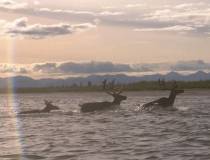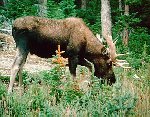| In late 2001, the U.S. administration was driven to respond to new
energy security concerns following the September 11, 2001 terrorist attacks.
It began looking in earnest toward oil drilling in the Arctic National
Wildlife Refuge (ANWR). The ANWR is located in the northeastern corner
of Alaska, along the border with the Yukon Territory. The Porcupine Caribou
herd calves in the ANWR and migrates into the Yukon on its annual trek.
Aboriginal peoples in both jurisdictions and the Mackenzie Delta of the
NWT depend heavily on this herd for subsistence.
When Environment Minister David Anderson heard the renewed calls to
open ANWR to oil drilling, he did the right thing. Speaking to Reuters
on September 25, 2001, he said that he hoped the U.S. "will not make a
hasty and ill-considered decision to allow oil exploration in the Arctic
National Wildlife Refuge because of the attacks." Canada's position on
this issue, which clearly affects the interests of Aboriginal Canadians,
has been consistent opposition to oil resource development. On our side
of
the border, we've created two National Parks called Ivvavik and Vuntut,
to safeguard the herd's habitat. Move about a thousand kilometers west
along Canada's northern coastline, however, and the story is quite, quite
different. The Bathurst Caribou
herd calves in the area of Bathurst Inlet, a long, deep inlet in our
coastline just south of Victoria Island. The inlet and calving grounds
lie in the westernmost portion of Nunavut but the herd, like its western
cousin, migrates across a border. The Bathurst herd migrates far south
into the Northwest Territories. Many Aboriginal communities in the NWT
still depend on the herd as their sole source of fresh, nutritious meat.
Far fewer Inuit in Nunavut hunt the herd.
Nunavut wants to build a deep-sea port right in the calving grounds
of the herd, where it would be used to store fuel oil for resupplying mines
and communities and store metal ores for shipment to smelters. It wants
to connect the port site to the mineral and diamond-rich territory to the
southwest by a 215 km all-weather road-a road that would pass through the
migratory route followed by the Bathurst Caribou herd from April through
October. This idea, in one form or another, has been around for a
long time. Funding from the (former) Government of the Northwest Territories
kept the idea alive through repeated study during the 1990's at a cost
of a couple of million dollars.
In 2001, the Federal Government granted over $3 million for a feasibility
study through Indian and Northern Affairs (INAC), the Ministry responsible
to protect the North and develop the North. This Ministry will ultimately
be responsible for deciding whether or not the project goes ahead, because
the developer needs federal funds to make it work. CARC believes the federal
government's position on the protection of caribou calving grounds should
be consistent and principled. We cannot seriously expect to pour money
into developing our own calving grounds and yet prevent the U.S. from doing
the same.
The environmental assessment process. The Kitikmeot Inuit Association's
development corporation is the proponent of the Bathurst Inlet Port and
Road Project (BIPAR), and it isn't interested in seeing its proposal go
to a joint environmental review with the Northwest Territories. It has
urged the Nunavut Impact Review Board to conduct a "Part 5" assessment
under the Nunavut Land Claims Agreement. The Board has thus far agreed,
that a public review is necessary, and has suggested that a Part 5 review
is adequate.
The Minister has also heard from the Government of the NWT, several
Aboriginal communities in the NWT, the Bathurst Inlet Port and Road Committee,
the Mackenzie Valley Environmental Impact Review Board, WWF and, of course,
CARC. All correspondents have strongly urged a joint or "Part 6" review,
with intervenor funding to enable meaningful participation of Aboriginal
and non-governmental organizations and communities. There is no guarantee
of participant funding under a Part 5 review, no provisions for appointments
to the Panel from outside Nunavut and no requirements for Public hearings
outside of Nunavut.
The costs and benefits of the project. The BIPAR was originally intended
to link a base metal deposit at Izok Lake with the proposed port, making
it profitable to develop this and many other mineral claims in the area.
Metal ores are far too heavy to fly out for smelting so, unlike diamonds
and gold, these deposits can generally only be mined when cheaper road
and/or water transportation is available. The owner of the Izok deposit,
Inmet Mining Corporation, was initially interested in partnering in the
project but, when the price of base metals recently dropped, they dropped
the project, too.
Now, the project is changed: the proponents say they won't complete
the link to Izok Lake. That may make immediate economic sense to them,
but it also defeats the development value of the project. The point was
to create jobs in construction and mining. Now, it seems the point is only
to deliver fuel oil to the Diavik and BHP diamond mines at a cost reduction
of $0.20 per litre. Both mines were extensively (if imperfectly) reviewed
during their approval processes, and were expected to be profitable without
this fuel cost reduction.
There are a lot of questions to be answered here, by whatever means
of review is chosen. The first one would be, "should we do this?" Is there
truly economic development potential here, that outweighs the risks involved
in taking oil tankers through the Northwest Passage, moving toxic metal
ores through the barrenlands, and disrupting the migration and calving
of the economically important Bathurst Caribou herd? Is there a better
sustainable development strategy that the Kitikmeot communitites could
pursue, that would not leave the region subject to the boom-and-bust cycles
of mine development? Our second question would be "if there
is a good economic reason to develop the road and port, can it be done
elsewhere, with fewer impacts on the herd and the marine mammals and fish
of Bathurst Inlet?". Could the road be simply a winter road, to avoid impacts
on caribou and the grizzly population? Could the road be routed so as to
be outside the Bathurst caribou herd calving grounds?
The problem is that none of these questions can be answered easily,
because there is no common ground as to what impacts on the ecology, society
or economy of this region will be considered acceptable, either locally,
in the Territorial capitals, or in Ottawa. These are questions that CARC
is striving to answer with its multi-year programme, Plan for the Land.
The climate and the coastlines of the Arctic are changing so rapidly,
that we owe it to ourselves to ensure that any long-term infrastructure
project such as this is assessed with the utmost care and foresight. The
cumulative effect of this development, and all of those likely to spring
up around it, combined with climate change, may well put the Bathurst herd
'over the edge'.
The matter now rests with Minister Nault. You can let him know what
you think:
Hon. Robert Nault, email: Nault.R@parl.gc.ca
Minister of Indian and Northern Affairs
House of Commons
Fax: 613-996-1759 or 953-4941
Parliament Buildings
Ottawa, Ontario K1A 0A6
Telephone: 613-996-1161
For further information, please contact the Canadian Arctic Resources
Committee.
Credit : Arctic Resources Committee: http://www.carc.org.
This information was found in Black
Feather newsletter
|


